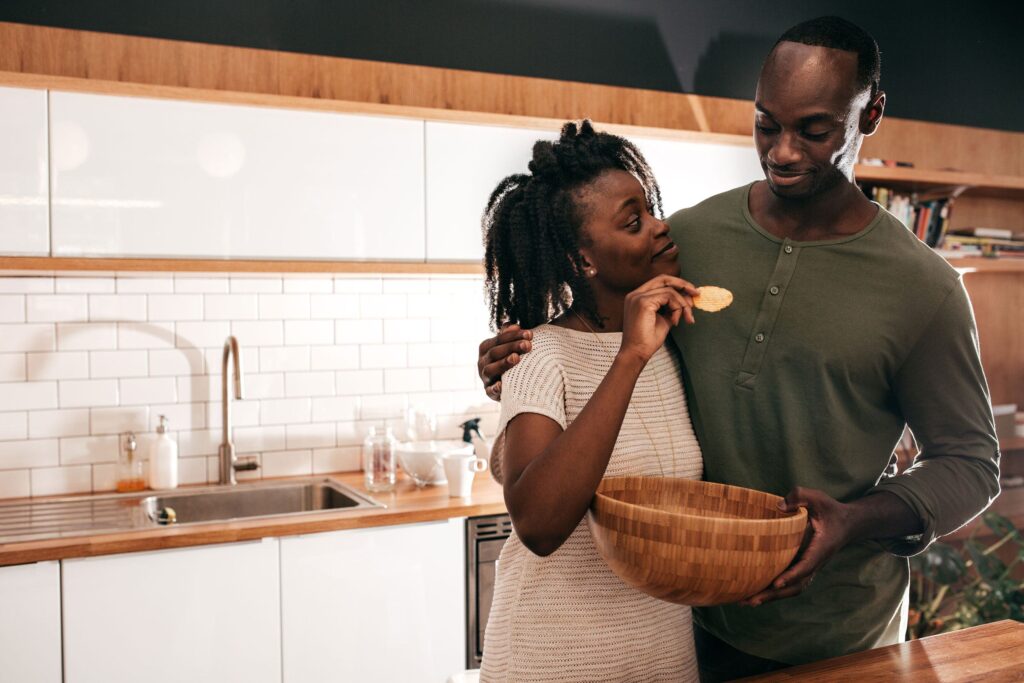The Perfect Balance or a Ticking Time Bomb?
Household Balance: Myth or Reality?
Have you ever felt like you always end up with more to do? As if the sink full of dishes is staring right at you, saying, “Good luck, dear”? The division of tasks and responsibilities in a relationship is one of those topics that seem simple on paper but, in real life, can turn into actual battlefields.
The idea of household balance is often promoted as an unattainable ideal. In theory, everything seems fair and organized, but in practice, challenges arise that destabilize any initial agreement. This happens because each person has their own perception of what “balance” means. For some, splitting chores equally means each person does 50% of the work, while for others, what matters is that each contributes according to their skills, time, and preferences.
Another complicating factor is the historical and cultural burden. For decades, many household responsibilities fell on women, even when they also worked outside the home. This “invisible inheritance” still impacts many modern relationships, where, even unconsciously, there is an unequal distribution of responsibilities.
But the big question is: Is there really a foolproof method to achieve this long-dreamed-of balance? Or is the solution found in flexibility and ongoing negotiation between partners?
The real secret to avoiding conflict is understanding that balance does not necessarily mean an exact 50/50 split. What works for one couple might not work for another. It all comes down to communication and recognizing each other’s efforts. When both partners see what the other is doing and value those contributions, the relationship becomes more harmonious.
Ultimately, if a couple understands that a home is a shared project, not just the responsibility of one side, it becomes much easier to find effective ways to maintain balance without overburdening one another. Small adjustments in daily routines and the way tasks are delegated can transform an environment of resentment and frustration into one of cooperation and partnership.

The Silent War of Invisible Tasks
The division of tasks and responsibilities within a relationship has always been a sensitive topic. For many couples, this issue can be a source of harmony or a constant source of disagreements. After all, how do you balance obligationswithout overloading anyone? Is there a magic formula for equality at home? Let’s explore effective strategies and understand what really works.
The Silent War of Invisible Tasks
Many daily tasks are obvious: doing the dishes, sweeping the floor, cooking. But what about those obligations that no one notices until they’re not done? Replacing the toilet paper, remembering to buy milk, scheduling doctor’s appointments, organizing the kids’ school supplies—these are the so-called invisible tasks, and their burden often falls on just one partner.
This type of mental and emotional labor can go unnoticed, but its impact is profound. When only one person takes on the responsibility of planning, remembering, and managing small (and big) household duties, the accumulated stress turns into frustration and resentment. The invisible mental load is one of the greatest villains of domestic inequality, as it is often not recognized as real work.
The silent war of invisible tasks happens because the partner who does not perform them may not realize their importance. “But you’re just at home!”, “I help when I’m asked!”, “That’s all in your head!”—phrases like these highlight how responsibilities can be unfairly divided without any real intention to cause harm.
The solution? Awareness and communication. Making a list of invisible tasks and sharing them can be a great first step. Additionally, establishing a routine for reviewing and adjusting responsibilities prevents one person from feeling overburdened while the other believes they are contributing equally.
Implementing tools like shared lists, household organization apps, and weekly meetings to redistribute duties can transform a couple’s dynamic. The key is recognizing that invisible tasks are also work and should be valued and fairly distributed.

Household Balance: Myth or Reality?
Is it really possible to divide tasks fairly? This question may generate different answers depending on each couple’s perspective. The truth is that, in many relationships, household balance is still a distant ideal. But that doesn’t mean it’s impossible to achieve.
For a healthy relationship, both partners must be willing to communicate and negotiate. It’s not just about splitting chores but about creating an environment where both feel valued and respected. After all, a home is not just a physical space—it’s a reflection of partnership, care, and mutual commitment.
True equity requires constant adaptation. Some phases of life will demand more from one partner than the other, and that’s okay—as long as there is recognition and reciprocity. The key is to maintain an open conversation and adjust responsibilities as needed.
At the end of the day, household balance is not a fixed destination but an ongoing process of adjustments and learning. When both partners acknowledge each other’s efforts and contribute fairly, daily life becomes lighter and more fulfilling.
The Power of Clear and Direct Communication
Many misunderstandings about task division and responsibilities happen because one partner believes the other should “know” or “notice” what needs to be done. The problem is that no one is a mind reader. Lack of direct communicationleads to accumulated frustrations, recurring arguments, and even long-term resentment.
A clear and direct conversation is the first step toward a more balanced division of responsibilities. But it’s not enough to just point out what’s wrong; it’s essential to express feelings and expectations in a constructive way. Instead of saying, “You never help me!” try something like, “I feel overwhelmed when I do all the tasks alone. Can we divide them more fairly?”
Additionally, setting specific responsibilities reduces conflict. Instead of “helping,” the ideal approach is for each person to have fixed, previously agreed-upon tasks. This prevents the classic scenario where one person does everything while the other only acts when asked. Partnership is not about helping; it’s about shared commitment.
Another crucial point is to maintain open and continuous communication. Regularly reviewing task distribution, expressing dissatisfaction before it turns into a bigger issue, and acknowledging the other person’s efforts make a huge difference. Small gestures, like saying, “Thank you for doing that,” strengthen the sense of teamwork and partnership in the relationship.
In the end, the secret lies in the willingness to listen and adjust. When both partners feel heard and valued, daily life becomes lighter and more balanced.

Effective Methods for a Fair Task Division
Now that we understand the challenges, let’s get to what really works. The good news is that there are strategies that can help. Here are some of them:
1. The “Who Notices, Does It” Rule
If you see something that needs to be done, do it. Simple as that. Waiting for the other person to take initiative can create a cycle of blame and resentment. If you notice the trash is full, take it out. If the bathroom needs cleaning, take the initiative.
2. Division Based on Preferences
Some people hate washing dishes but don’t mind cooking. Others prefer organizing the house rather than ironing clothes. Understanding what each person dislikes and enjoys doing can make the division smoother and less frustrating.
3. Rotation System
One week, one person does the dishes; the next, the other does it. This prevents the feeling that one person is always overburdened.
4. Visible Lists and Agreements
Writing down tasks and responsibilities on a board or using a shared app helps visualize what has already been done and prevents unnecessary conflicts.
5. Small Incentives
Have you ever tried turning chores into something fun? Playing upbeat music while cleaning together can change how the task feels. Small rewards also help: “If we finish this quickly, we can order a pizza afterward.”
Building a Lighter and More Balanced Relationship
Building a healthy and balanced relationship doesn’t mean avoiding challenges but rather facing them in a healthy and collaborative way. The dynamics of a couple require dialogue, understanding, and the willingness to grow together. Small daily actions make all the difference in creating a harmonious and fulfilling environment for both partners.
Communication as a Fundamental Pillar
One of the key pillars of a balanced relationship is effective communication. This means not only expressing personal feelings but also actively listening to your partner. Clear communication prevents misunderstandings and strengthens complicity, making discussions more productive and less exhausting.
Task and Responsibility Division
A fair division of household responsibilities is one of the most sensitive issues in any relationship. To avoid resentment and overload, it’s important to establish clear agreements and respect each other’s needs. Tools like shared lists, weekly planners, and even apps can help maintain balance.
Respecting Individual Space
A healthy relationship doesn’t mean total fusion between partners. On the contrary, maintaining individuality is essential for personal growth. Encouraging hobbies, alone time, and individual interests enriches the relationship and prevents it from feeling suffocating.
The Power of Empathy
Putting yourself in your partner’s shoes can prevent many unnecessary conflicts. Understanding their challenges, pressures, and difficulties makes living together more harmonious. A simple “How was your day?” or “Can I help you with something?” can completely change the atmosphere of a relationship.
Maintaining Affection and Connection
Routine can be a relationship killer, making things feel mechanical and emotionless. Small daily gestures of affection, unexpected surprises, and quality time together keep the spark alive. Prioritizing the relationship and creating special moments are key to maintaining a strong and fulfilling bond.
Flexibility and Patience
Things won’t always go as planned, and that’s okay. Having flexibility to deal with unforeseen events and patience to understand different relationship phases helps prevent unnecessary stress. Accepting that both partners are human and prone to mistakes is a crucial step toward a lighter and more balanced life together.
Balanced relationships don’t happen by chance; they are built with dedication, respect, and mutual love. Small adjustments in communication, task division, and expressions of affection can transform a couple’s dynamics, creating a strong foundation for a happier life together.

Small Changes, Big Results
At the end of the day, building a balanced relationship is a team effort. Small daily changes can transform everyday life, creating a lighter and more harmonious environment.
And you—how do you divide tasks with your partner? Share your experience in the comments!






